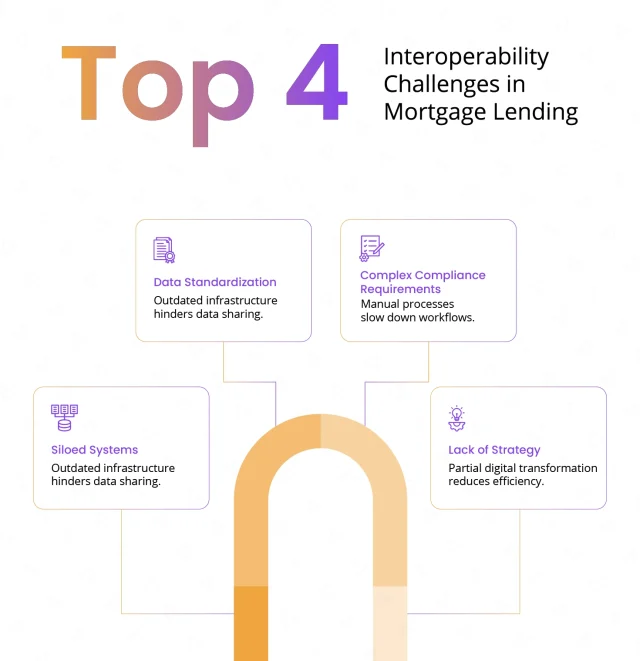Introduction:
Against this backdrop, as mortgage lenders are striving to optimize their operations
and add value to their service offerings, digital transformation is increasingly gaining traction as a credible driving force toward achieving enhanced efficiency and better margins. But, the lenders also face significant interoperability challenges stemming from legacy systems and disparate data sources which makes it difficult to overhaul their tech stack.
The key to overcoming these challenges lies with a solution that offers both efficiency and interoperability at the same time.
An IDP solution is one such offering that enables seamless integration across systems and workflows, offering tremendous value in data extraction and standardization from various mortgage documents.
In this blog, we will first delve into the interoperability challenges faced by mortgage lenders while embarking on their digital transformation journey, followed by exploring the fascinating world of intelligent document processing and its intricate details.
Challenges
Here are some of the major issues that pose serious challenges:
- Siloed Systems
When it comes to adopting digital transformation, it is found that many mortgage lenders operate on outdated, siloed infrastructure that hinders data sharing and collaboration. Under such a fragmented approach, interoperability becomes a challenge. - Data Standardization
The lack of a single standardized data format compromises the effective integration of systems and information from varied sources, leading to operational inefficiencies stemming from inaccuracies and duplications. This becomes considerably challenging while dealing with third-party data and maintaining related compliance requirements. - Complex Compliance Requirements
Talking about compliance, its requirements from multiple stakeholders, and fulfilling them through manual processes is always a time-consuming process. Therefore, to streamline it, integration of various technologies is required, which often poses interoperability challenges. - Lack of Comprehensive Strategy
Many mortgage lenders lack a unified digital transformation strategy. As a result, partial implementation of digitization fails to address the overall efficiency and productivity objectives, mostly arising out of hindrances faced in interoperability between manual and digitized workflows.

Thus, addressing these challenges through an all encompassing digital transformation solution is required to deliver efficiency to mortgage workflows.
Solutions
1. Achieving Efficiency with IDP Solutions :
By seamlessly integrating intelligent document processing (IDP) with existing enterprise systems, organizations can significantly boost operational efficiency and productivity. A key aspect of IDP interoperability is defining how data extracted by the IDP solution corresponds to fields in ERP or CRM systems.
This data mapping ability of IDP solutions ensures extracted information such as invoice number or amount is accurately populated in the correct system fields. The major benefit of this interoperability of the IDP system is improving data accuracy by avoiding errors inherent in human processing.
Thus, IDP solutions help streamline workflows, enhancing productivity along with tangible cost savings through their interoperability attribute.
2. Various technology combinations and their workings, as a part of IDP solution, in providing interoperability:
A closer look into the combination of various technologies and their inner workings reveals how, by utilizing these technologies, intelligent document processing (IDP) unlocks numerous value additions to mortgage industry workflows. Particularly, interoperability in optical character recognition (OCR) is achieved through the integration of various technologies, including positional OCR, regression locator algorithms, artificial intelligence (AI), large language models (LLMs), and machine learning (ML). Let’s explore the workings of these various technologies in bringing interoperability leading to efficiency:
- Positional OCR
While dealing with Out-of-Domain (OOD) documents during document processing, often repetitive degeneration issues are encountered. By incorporating position guidance into the transformer architecture during autoregression, positional OCR addresses this issue, enabling the document processing model to handle complex layouts and generate content in ‘Markdown Language’. - Regression Locator Algorithm
During document processing, a regression locator helps in text segmentation by dividing the text into individual characters and then identifying the region of an image that has text. Such text localization ability by predicting bounding boxes around text elements, adds tremendous efficiency in data extraction while dealing with complex document layouts. - AI, LLMs, and ML
The potent combination of the regression locator algorithm with AI, LLM, and ML enhances the overall performance of any OCR system by leveraging the location data provided by the regression algorithm, leading to improved text recognition accuracy and content understanding. The outcome of this technology integration is better interoperability between different systems and applications that ultimately provide robust handling of diverse document types and formats.
Conclusion
By employing IDP solutions such as DocVu.AI, it is possible to harness the combined benefit of various technologies, resulting in achieving very high accuracy in dealing with complex fonts, languages, languages, and document formats. While this enhances the data extraction quality and efficiency, the ability to even add value to post-processing corrections is phenomenal.
DocVu.AI as an IDP solution, provides dictionary-based corrections, spell checking, and context analysis, improving error correction and text detection precision. This interoperability capability makes the digital transformation of document processing workflows, with IDP solutions such as DocVu.AI, highly efficient, facilitating data accessibility, intelligent automation, and technology integration.
CTA
Connect with us at: www.docvu.ai






